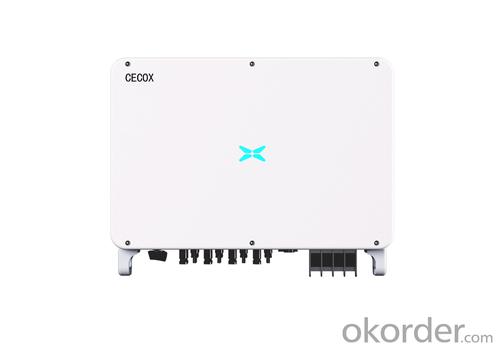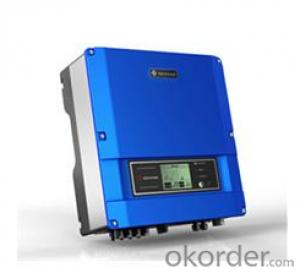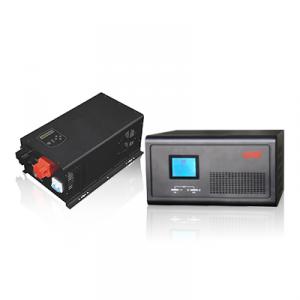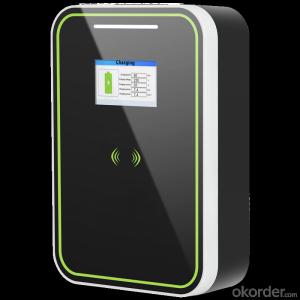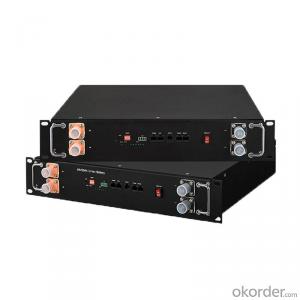3kVA Solar Inverter - 50kw 60kw 66kw 70kw Three Phase On-Grid Solar Inverter
- Loading Port:
- SHENZHEN
- Payment Terms:
- TT OR LC
- Min Order Qty:
- 30 unit
- Supply Capability:
- 500 unit/month
OKorder Service Pledge
OKorder Financial Service
You Might Also Like
Specification
XG50kW-70kW
Three Phase On-Grid Solar Inverter
XG50KTR | XG50KTRL | XG60KTR | XG60KTRL | XG66KTRL | XG70KTRL | |
Input(DC) | ||||||
Max. Input Power | 80 kW | 96 kW | 105.6kW | 112kW | ||
Max. Input Voltage | 1100V | |||||
Start Voltage | 250V | |||||
Rated Input Voltage | 600V | 700V | ||||
Full-load MPP Voltage Range | 520V-850V | 600V-850V | ||||
MPPT Voltage Range | 200V-1000V | |||||
Number of MPP Trackers | 4 | |||||
Number of string per MPPT | 3/2/3/2 | 3/3/3/3 | ||||
Max.Current per MPPT | 39A/26A/39A/26A | 39A | ||||
Max.Short Circuit Current per MPPT | 48A/32A/48A/32A | 48A | ||||
Output(AC) | ||||||
Max. Output Current | 79.7 A | 66.2 A | 95.6 A | 79.4 A | 87.4A | 96.2A |
Rated Output Power | 50 kW | 60 kW | 66kW | 70kW | ||
Max. Output Power | 55 kVA | 66kVA | 72.6kVA | 77kVA | ||
Rated Grid Frequency | 50 Hz / 60 Hz | |||||
Rated Grid Voltage | 230Vac / 400Vac | 277Vac / 480Vac | 230Vac / 400Vac | 277Vac/480Vac | ||
Power Factor | >0.99 (0.8 leading~0.8 lagging) | |||||
THDi | <3% (Rated Power) | |||||
Efficiency | ||||||
Max. Efficiency | 98.70% | 98.80% | ||||
European Efficiency | 98.40% | 98.50% | ||||
MPPT Efficiency | 99.90% | |||||
Protection | ||||||
DC reverse polarity protection | Yes | |||||
Anti-Islanding protection | Yes | |||||
AC short circuit protection | Yes | |||||
Residual current monitoring unit | Yes | |||||
Insulation resistance monitoring | Yes | |||||
Ground fault monitoring | Yes | |||||
Grid monitoring | Yes | |||||
PV string monitoring | Yes | |||||
Surge protection | Type II | |||||
AFCI protection | Optional | |||||
Communication | ||||||
Display | LED / LCD / WiFi+App | |||||
Communication | Standard:RS485 Optional:WiFi / GPRS / Ethernet | |||||
Standard Compliance | ||||||
Grid Connection Standards | IEC 61727, IEC 62116, IEC 60068, IEC 61683, VDE-AR-N 4110:2018, VDE-AR-N 4105:2018, VDE-AR-N 4120:2018, EN 50549, AS/NZS 4777.2:2020, CEI 0-21, VDE 0126-1-1/A1 VFR2014, UTE C15-712-1:2013, DEWA DRRG, NRS 097-2-1, MEA/PEA, C10/11, G98/G99 | |||||
Safety/EMC | IEC 62109-1:2010, IEC 62109-2:2011, EN 61000-6-2:2005, EN 61000-6-3:2007/A1:2011 | |||||
General Data | ||||||
Dimensions (W*H*D) | 650 x 450 x 260 mm | |||||
Weight | 50 kg | |||||
Operating Temperature Range | -30° C ~ +60° C | |||||
Cooling Method | Smart Cooling | |||||
Protection Degree | IP66 | |||||
Max. Operating Altitude | 4000 m | |||||
Relative Humidity | 0 ~ 100% | |||||
Topology | Transformerless | |||||
Night Power Consumption | < 1 W | |||||
MARKETING & SERVICE NETWORK
CNBM global sales team provides customers with professional and efficient pre-sale,
in sale and after-sale services, and enhances the added value of the brand with high-quality services.
Products Details:
High voltage protection Over load protection
Battery reverse connected protection Dust-proof
Low voltage protection Overheating protection
Output short-circuit protection Insect prevention
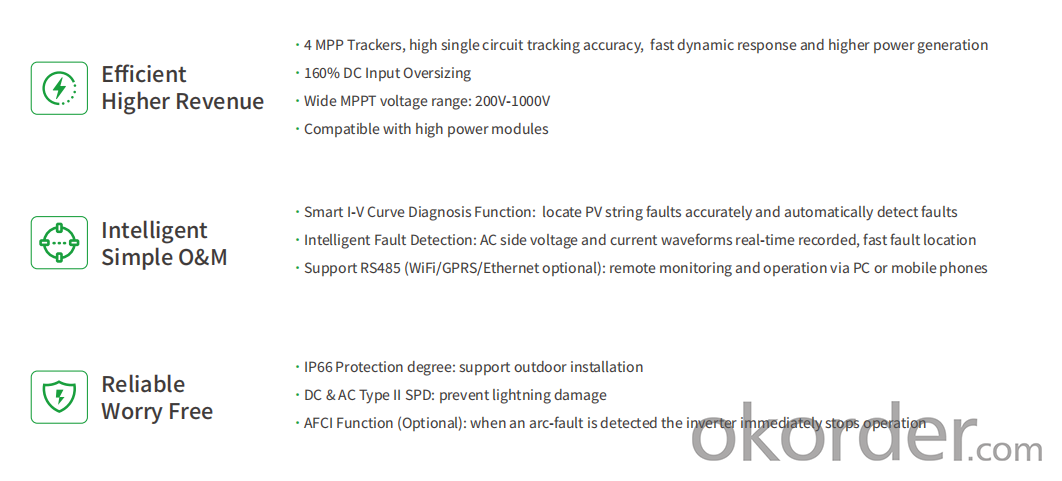
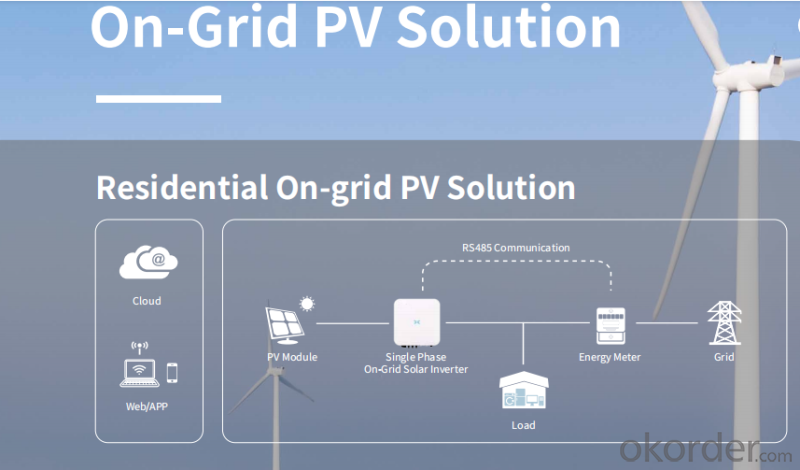
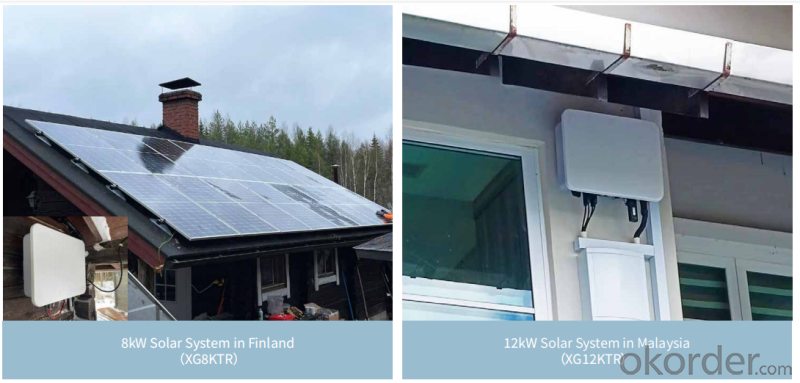


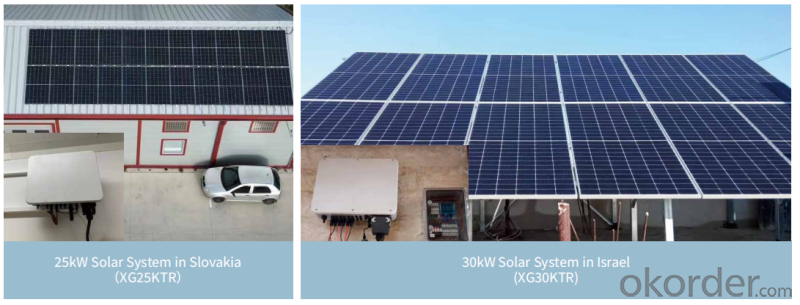
FAQ:
Q1:May I take some samples to test before placing the order ?
A1:Yes, welcome to take some sample to test!
Q2:How about the delivery time?
A2:7 days for sample; 25 days for bulk order.
Q3:What is the warranty of the controller?
A3:1 years warranty.
Q4:How to solve the technical problems?
A4:24 hours after-service consultancy just for you and to make your problem to be solved easily.
Q5:What payment methods do your company support?
A5:T/T, Western Union, Paypal, L/C etc.
Q6:What are the price terms can you offer for us?
A6:We can accept EXW, FOB, CIF and so on.
Q7:Do you have any certifications for your products?
A7:We have ISO9001:2000, CE, RoHS, certificates for all of our products.
- Q:What is the role of a solar inverter in a solar power system?
- The role of a solar inverter in a solar power system is to convert the direct current (DC) electricity produced by the solar panels into alternating current (AC) electricity that can be used to power household appliances and be fed back into the electrical grid. The inverter also ensures that the power generated by the solar panels is at the correct voltage and frequency for safe and efficient use.
- Q:Can a solar inverter be used in extreme weather conditions?
- Yes, solar inverters are designed to withstand a wide range of weather conditions, including extreme heat, cold, humidity, and even harsh environmental factors. They are built to be durable and reliable, ensuring their functionality and performance in various climates and weather conditions.
- Q:What are the common troubleshooting steps for a malfunctioning solar inverter?
- The common troubleshooting steps for a malfunctioning solar inverter typically include checking the connections and cables for any loose or damaged parts, inspecting the inverter display for error messages or warning lights, resetting the inverter by turning it off and on, and ensuring that the solar panels are receiving sufficient sunlight. If these steps do not resolve the issue, it may be necessary to consult a professional technician or the manufacturer for further assistance.
- Q:How does a solar inverter synchronize with the grid frequency?
- A solar inverter synchronizes with the grid frequency by continuously monitoring the frequency of the electrical power supplied by the grid. It adjusts its own output frequency to match the grid frequency using a built-in control mechanism. This synchronization ensures that the solar inverter's power is in phase with the grid power, allowing it to smoothly inject electricity into the grid without causing disruptions or power quality issues.
- Q:What is the role of a bypass switch in a solar inverter?
- The role of a bypass switch in a solar inverter is to provide an alternate path for the solar energy to flow in case of a fault or failure in the inverter. It allows the solar power to bypass the inverter and directly feed into the grid or another designated load, ensuring continuous power supply and preventing any disruptions in the system.
- Q:How do you choose the right input voltage range for a solar inverter?
- To choose the right input voltage range for a solar inverter, it is essential to consider the specifications and requirements of both the solar panels and the inverter. The input voltage range of the inverter should be compatible with the output voltage range of the solar panels. It is important to ensure that the inverter can handle the maximum voltage generated by the panels during peak sunlight conditions. Additionally, factors such as temperature variations and system losses should also be taken into account while selecting the appropriate input voltage range for a solar inverter.
- Q:Can a solar inverter be used with a smart home system?
- Yes, a solar inverter can be used with a smart home system. In fact, integrating a solar inverter with a smart home system allows for better monitoring, control, and optimization of the solar energy production and consumption in the home. This integration enables homeowners to track their energy usage, maximize self-consumption, and even automate certain appliances or systems based on the availability of solar power.
- Q:How does a solar inverter affect the overall system reliability?
- A solar inverter plays a crucial role in the overall system reliability of a solar power system. It converts the direct current (DC) generated by solar panels into alternating current (AC) that is compatible with the electrical grid. By efficiently and accurately converting the power, a high-quality solar inverter ensures optimal energy production and grid integration. It also helps in voltage regulation, frequency control, and protection against grid faults. Therefore, a well-functioning and reliable solar inverter significantly enhance the overall system reliability, maximizing the overall efficiency and longevity of the solar power system.
- Q:How does a solar inverter affect the overall system cost?
- A solar inverter can have a significant impact on the overall system cost. While it is a crucial component that converts DC power generated by solar panels into AC power for use in homes or businesses, it also adds to the total expenses of installing a solar system. The cost of a solar inverter depends on factors such as its capacity, efficiency, and features. Higher capacity or more advanced inverters tend to be more expensive. However, investing in a high-quality inverter can improve the overall efficiency and performance of the solar system, potentially offsetting the additional cost in the long run.
- Q:Can a solar inverter be used with batteries for energy storage?
- Yes, a solar inverter can be used with batteries for energy storage. In fact, this is a common practice in solar power systems, where excess energy generated by the solar panels is stored in batteries for later use when the sun is not shining. The solar inverter plays a crucial role in converting DC power from the batteries into usable AC power for electrical appliances.
1. Manufacturer Overview |
|
|---|---|
| Location | |
| Year Established | |
| Annual Output Value | |
| Main Markets | |
| Company Certifications | |
2. Manufacturer Certificates |
|
|---|---|
| a) Certification Name | |
| Range | |
| Reference | |
| Validity Period | |
3. Manufacturer Capability |
|
|---|---|
| a)Trade Capacity | |
| Nearest Port | |
| Export Percentage | |
| No.of Employees in Trade Department | |
| Language Spoken: | |
| b)Factory Information | |
| Factory Size: | |
| No. of Production Lines | |
| Contract Manufacturing | |
| Product Price Range | |
Send your message to us
3kVA Solar Inverter - 50kw 60kw 66kw 70kw Three Phase On-Grid Solar Inverter
- Loading Port:
- SHENZHEN
- Payment Terms:
- TT OR LC
- Min Order Qty:
- 30 unit
- Supply Capability:
- 500 unit/month
Offcanvas right
OKorder Service Pledge
OKorder Financial Service
Similar products
New products
Hot products
Hot Searches
Related keywords




